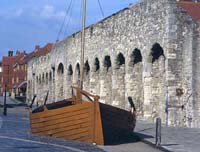| |
 |
Southampton |
Southampton had been an important trading settlement in Saxon times, situated on the western side of the River Itchen. During the 10th century the focus of settlement changed to the south-west corner of the peninsula between the Test and Itchen. It was here that a new urban centre and port developed which, following the Norman Conquest, served as the vital link between England and Normandy.
The central axis of the town was English Street, running north to south. To the west and running parallel were two other streets named Bull Street and French Street. It was this area that became the French quarter of the Post-Conquest town. Here a castle was built and churches founded, such as St. Michael, named after the patron saint of Normandy.
Housing had traditionally been of timber, in-filled with wattle and daub, but by the end of the 12th century wealthy merchants were building stone houses with cellars. Charters highlighting these changes identify the leading burgesses of the day. By the 13th century stone buildings could be seen all over the enclosed town.
The houses that survive in Southampton today are rare examples of domestic Norman architecture. King John's Palace at Blue Anchor Lane, the Norman House in Cuckoo Lane and Canute's Palace at Porters Lane are the most impressive. They consist of domestic quarters situated on the upper floor over a warehouse which provided storage for commodities, such as wine and other goods.
The French raids in 1338 brought about the construction of new town defences. Along the quay on the west side of the town, where the wealthy Norman merchants had built their houses, a wall was constructed. Instead of enclosing the houses the seaward facades were incorporated into the wall, where the windows and doors of these 12th century houses can still be clearly seen today.
Kay Ainsworth
Bibliography
Pevsner, N., and Lloyd, D., 1967. The Buildings of England, Hampshire and the Isle of Wight (London, Penguin), 521-4 (St Mary's), 533-41 (defences and King John's House), 550 (Canute's Palace)
Platt, C 1973 Medieval Southampton. The Port and Trading Community, A.D.1000-1600 (London)
Platt, C., and Coleman-Smith, R. et al., 1975. Excavations in Medieval Southampton 1953-1969, 2 vols (Leicester)